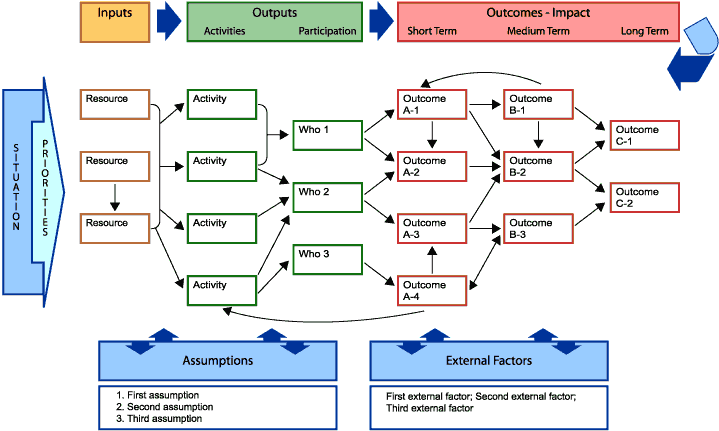Home » Enhancing Program Performance with Logic Models » Section 3: More about Your Program “Logic” » 3.5: Multiple chains and directional flows
3.5: Multiple chains and directional flows
Our programs are seldom as simple as the single chain of if-then relationships previously considered. More likely, there are several chains of connections, and vertical as well as circular flows of action. It may be more realistic to think of a program as a spiral involving various feedback loops. For example, a policy change can lead back to changes in knowledge and attitudes that, in turn, lead forward to behavioral change. Certainly this spiral effect happens when we take the knowledge gained during implementation and use that knowledge to improve a program (for example, we see that the targeted numbers of participants are not attending so we feed that information back into redesigning our educational outreach and activities) or to inform the next planning cycle. Or, a program causes a change in an external factor that, in turn, affects program direction.
Often, program logic models have:
- Several branches (Funnell, 2000) or lines of connections (chains, causal models).
- Multiple lines or chains, and arrows.
- Feedback loops.
- Several or various theories of change (see Weiss, 1998 and Rogers, 2000).
- Alternative pathways of change
The following graphic depicts multiple chains and directions of expected causal linkages.

This graphic of a logic model more realistically depicts a multi-faceted program. The programs that many of us work in seldom are so simple that a single line of boxes and arrows accurately represent reality. In this logic model, you see a number of rows that depict various sequences of events and arrows showing both vertical and horizontal flows and feedback loops. The several lines or branches might represent different activities or target audiences and the sequence of events pertaining to each. Feedback loops are common in most programs. As we learn, we feed that information back into the program and modify it. Or, something may happen that causes the program to redirect. Actual program implementation is more complex and fluid than a single line of boxes and straight arrows represents.




